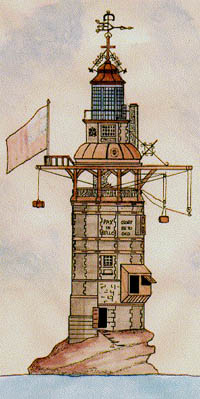Henry Winstanley
Today, welearn to be careful what we wish for. The University of Houston's College of Engineering presents this series about the machines that make our civilization run, and the people whose ingenuity created them.
Henry Winstanley was the unlikely builder of the first Eddystone Lighthouse. Born in 1644, he was a true creature of the marvelous seventeenth-century. This was the age of invention. It was the coming-of-age of modern science. It was the epoch that would give us Newton, Leibnitz -- and the steam engine.
Winstanley took up the trade of engraving. He made architectural plans and renderings and he developed a reputation for gadgeteering. He became wealthy by operating an odd theatre in Piccadilly. Winstanley's Waterworkes was a showplace for wild combinations of fountains and fireworks. He invested the wealth that it gained him in ships. He ultimately owned five.
Although Britain had become the world's great seafaring nation, her ships faced one deadly threat -- the treacherous Eddystone Reef, fourteen miles off the Cornwall coast.
Sure enough, Winstanley lost not one, but two, of his ships on those rocks. After the second one, he decided something had to be done. In 1696, he went to the Admiralty with plans for a lighthouse; and he convinced them he could build it.
Erecting a lighthouse right at sea level on a tiny ocean-swept rock was a forbidding challenge, and he had his problems. Just as he started supervising the foundation, French privateers found him. They destroyed all he'd done; then they kidnapped him.
The British negotiated his release and he went back to work, this time with a new design. When he'd finished his lighthouse, he found that it creaked in the first severe storm. So he completely redesigned and rebuilt it. Now it rose eighty feet above an improved twenty-four-foot-diameter foundation.

It was a strange example of Rococo -- colorful and elaborate. Winstanley outfitted a fine luxurious stateroom within it, and proudly told the world that he wished he could "be in the light-house during the greatest storm that ever was"
That was 1703. Exactly three hundred years later, in 2003, a new edition of Daniel Defoe's first book, The Storm, was released. Defoe had written about a very rare event that occurred just as the lighthouse was finished. It was a hurricane in Great Britain -- exactly the greatest storm the British Isles ever suffered. It claimed eight thousand lives and did incalculable damage. So Henry Winstanley got his wish. He was in his lighthouse that night of November 26th.
When the skies finally cleared, and ships reached the Eddystone Rocks, Winstanley's great lighthouse was gone. And he was gone with it. New lighthouses were built, of course -- first of wood, then concrete. Today, the fifth Eddystone Light is an austere tower rendered in plain vanilla concrete. Built in 1882, it stands 180 feet above the sea. It is a cold functional structure -- surely a sad sight for the windblown ghost of Henry Winstanley.
I'm John Lienhard, at the University of Houston, where we're interested in the way inventive minds work.
The story of Henry Winstanley and his lighthouse is widely told on the web. See e.g.:
The Wikipedia article
And you can learn more about the Defoe connection from: C. Ash, The Havoc, Distraction, and Fury. Science, Vol. 303, 5 March, 2004, pg 1471.
R. H. Weston, Letters and Important Documents Relative to the Edystone Lighthouse, Selected Chiefly from the Correspondence of the Late Robert Weston, Esq. and From Other Manuscripts ... London, C. Baldwin, 1811.
The following children's book spins its own story around the lighthouse: W. H. Wood, The House in the Sea: A Story of the First Lighthouse on Eddystone. New York: Duell, Sloan and Pearce, 1954.
See also the Article on Winstanley in The Dictionary of National Biography.

An early nineteenth-century artist's impression of Smeaton's Eddystone Lighthouse in a Storm (from the Weston source, above.) This was the third Eddystone light, finished in 1759.